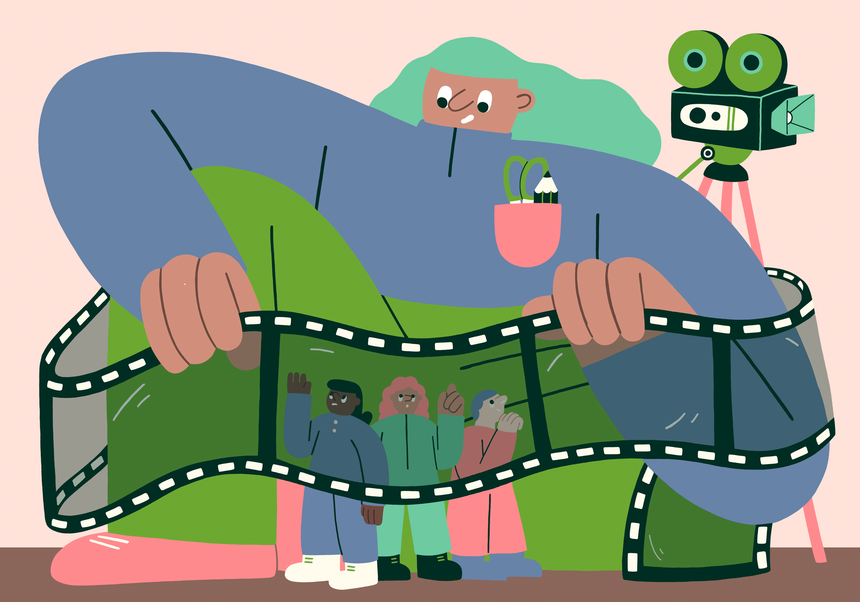Why editing can be a radical act
Jury President Paul Notice explains how editing can change the way we view the world, as well as make or break a piece of creative

Paul Notice is an Emmy Award-winning producer based in New York City, and a proud alumnus of Georgetown University (BS ’09) and NYU (MFA ’11). In their over 12 years as a filmmaker and journalist, they’ve produced and edited music videos, films, documentaries, and commercial projects with brands including MSNBC, OkayAfrica, and LYFT. Their notable works include “The Impact of Broken Windows Policing,” which deconstructs one of the most prominent myths driving over-policing in Black & Brown neighborhoods, and “Shaw Boyz,” which follows a group of young teens as they navigate a rapidly gentrifying environment in DC’s historical Shaw neighbourhood. Notice loves storytelling and the art of narrative stochasticity – here, as told to D&AD, they explain how editing can be a radical act.
Editing, like any practice, can be a radical act. Unless you’re an editor, or familiar with the practice of editing yourself, it can be easy to underplay the essential role editing fulfills in crafting a film’s narrative. A skillful editor could spend months crafting raw unscripted footage into something captivating, adding insight or depth to the story through intentional choices in sequencing clips, strategic use of text, or even choice of music. In fact, a nuanced and experienced editor will have the ability to change an audience’s worldview, both onscreen and off.
That change could spring from something as seemingly insignificant as choosing the stock footage. For instance, the editor could influence the way viewers perceive ‘family’, by simply selecting footage with Queer/BIPOC actors instead of the normalized depiction of a White nuclear family.
To better understand this practice, let’s do a quick case study on a 2014 Cheerios commercial. It was a short ad spot portraying a queer couple having breakfast with their child. Nevertheless, that ad challenged homophobic views still present in American society. Though it spurred controversy from the political Right, the commercial was still roundly applauded by consumers, media outlets, and advocacy groups alike. By showing these three as a family, and centering their narrative; Cheerios’ message rang clear: “Cheerios are for everybody”.
This isn’t to say that tokenism and Othering-as-spectacle don’t also exist. Rather, an editor must be intentional and genuine in their incorporation of marginalized narratives. They must be careful not to regard BIPOC/Queer/Femme/Differently-Abled bodies on-screen as props - or “a means to an end,” but rather as human beings, and an end in that of themselves. While one’s intention may seem minor, it can have an immense influence on the craft of the story, and thus the psyche of the viewer. Even a 30 or 60-second clip can speak volumes - if crafted with the right intention and eye for detail.
“While one’s intention may seem minor, it can have an immense influence on the craft of the story, and thus the psyche of the viewer”
Though editors involved at the beginning of the creative process may help to further embed these considerations into the narrative, they often join the production after filming. By then, certain elements, scenes, or even plot points might have changed from the initial script. There might even be some technical mishaps in capturing the film: a crew member caught in the shot, a lighting scheme set to the wrong temperature, a critical line needs to be replaced with ADR, and so on. At that point, a resourceful editor needs to work with what they’ve been given, and yet give the best possible product for their client.
Client management like this also requires high social literacy and a certain kind of assertiveness. One must be able to tactfully say, “Look, this wasn't my idea, but I can fix it.” Managing the expectations of a client isn’t easy, but it’s necessary for preserving a cohesive relationship throughout the production process. That isn’t to say that this is the only client-facing challenge one will face as an editor. In fact, it isn’t always easy to let go of a project once the creative direction steers away from what you’d advise as well. For me, I keep things fresh by balancing commercial work with passion projects like my new feature film MIRRORS, written by Azure Osborne-Lee; and my ongoing experimental series “The Notice Blog.”
“Client management like this also requires high social literacy and a certain assertiveness"
Though radical editing could never involve dispassionately stitching together video clips, if done with intention, it can convey the story as it was meant to be told. It is the editor who has the power to set the final tone of a film, and to achieve the director’s or client's vision. As editors, the choices we make can be radical, but only if we make the right choices.
D&AD Awards 2022 is now open for entries. Submit your work and be part of more.



